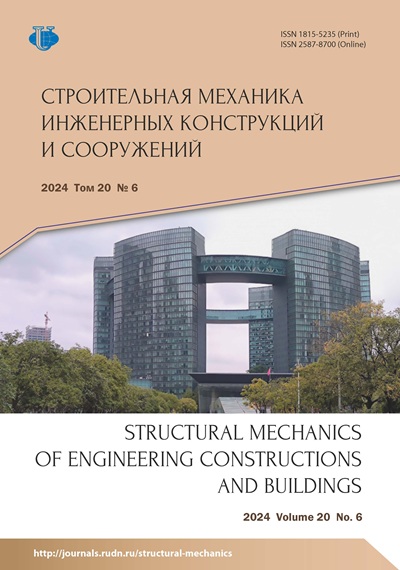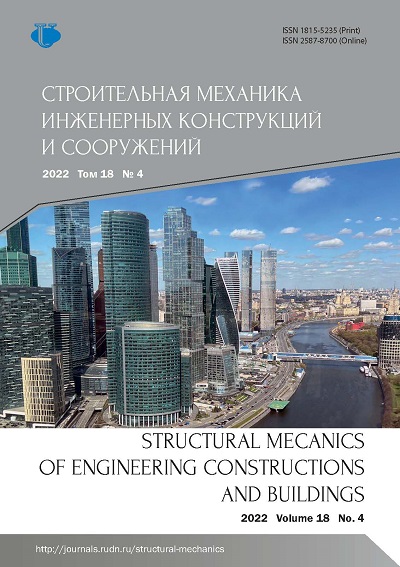Сравнительный анализ напряженного состояния оболочки одинакового ската аналитическим и численными методами
- Авторы: Алёшина О.О.1, Иванов В.Н.1, Кахамарка-Сунига Д.2
-
Учреждения:
- Российский университет дружбы народов
- Католический университет города Куэнки
- Выпуск: Том 18, № 4 (2022)
- Страницы: 375-386
- Раздел: Аналитические и численные методы расчета конструкций
- URL: https://journals.rudn.ru/structural-mechanics/article/view/32746
- DOI: https://doi.org/10.22363/1815-5235-2022-18-4-375-386
Цитировать
Полный текст
Аннотация
Исследование напряженно-деформированного состояния оболочки одинакового ската с эллипсом в основании не получило широкого распространения. Настоящая работа является частью серии статей, посвященных анализу геометрии и напряженного состояния торсов одинакового ската с направляющим эллипсом различными методами при различных нагрузках и условиях опирания. Представлен вывод дифференциальных уравнений равновесия безмоментной теории оболочек для определения внутренних сил в торсе с направляющим эллипсом под действием внутреннего давления. Аналитические результаты сравниваются с результатами, полученными методом конечных элементов (МКЭ) и вариационно-разностным методом (ВРМ). Определены преимущества и недостатки трех методов расчета и установлено, что результаты ВРМ точнее по сравнению с МКЭ, но программное обеспечение на основе МКЭ является более мощным инструментом для выполнения расчета конструкции.
Об авторах
Ольга Олеговна Алёшина
Российский университет дружбы народов
Автор, ответственный за переписку.
Email: xiaofeng@yandex.ru
ORCID iD: 0000-0001-8832-6790
кандидат технических наук, ассистент, департамент строительства, Инженерная академия
Российская Федерация, 117198, Москва, ул. Миклухо-Маклая, д. 6Вячеслав Николаевич Иванов
Российский университет дружбы народов
Email: i.v.ivn@mail.ru
ORCID iD: 0000-0003-4023-156X
доктор технических наук, профессор-консультант, департамент строительства, Инженерная академия
Российская Федерация, 117198, Москва, ул. Миклухо-Маклая, д. 6Давид Кахамарка-Сунига
Католический университет города Куэнки
Email: cajamarca.zuniga@gmail.com
ORCID iD: 0000-0001-8796-4635
доцент департамента строительства
Республика Эквадор, 010101, Куэнка, Ave Las Americas & HumboldtСписок литературы
- Иванов В.Н., Алёшина О.О. Сравнительный анализ параметров напряженно-деформированного состояния торса с направляющим эллипсом с помощью трех методов расчета // Строительная механика и расчет сооружений. 2020. № 3 (290). С. 37–46. https://doi.org/10.37538/0039-2383.2020.3.37.46.
- Aleshina O.O., Ivanov V.N., Cajamarca-Zuniga D. Stress state analysis of an equal slope shell under uniformly distributed tangential load by different methods // Structural Mechanics of Engineering Constructions and Buildings. 2021. Vol. 17. No. 1. Pp. 51–62. https://doi.org/10.22363/1815-5235-2021-17-1-51-62
- Алёшина О.О., Иванов В.Н., Гринько Е.А. Исследование напряженного состояния торсовой оболочки одинакового ската аналитическим и численными методами // Строительная механика и расчет сооружений. 2020. № 6 (293). С. 2–13. https://doi.org/10.37538/0039-2383.2020.6.2.13
- Иванов В.Н., Алёшина О.О. Сравнительный анализ результатов определения параметров напряженно-деформированного состояния оболочки одинакового ската с направляющим эллипсом в основании // Строительная механика инженерных конструкций и сооружений. 2019. Т. 15. № 5. С. 374–383. https://doi.org/10.22363/1815-5235-2019-15-5-374-383
- Aleshina O.O. New investigation of the stress-strain state of the torso-shaped awning // International Conference Scientific Research of the SCO Countries: Synergy and Integration. Beijin: Infinity, 2020. Pp. 130–136. https://doi.org/10.34660/INF.2020.26.58262
- Алёшина О.О. Исследования по геометрии и расчету торсовых оболочек одинакового ската // Строительная механика и расчет сооружений. 2019. № 3 (284). С. 63–70.
- Алёшина О.О. Определение закона задания замкнутых кривых торсовых оболочек одинакового ската // Инженерные системы – 2020: труды научно-практической конференции с международным участием, посвященной 60-летию Российского университета дружбы народов (Москва, 14–16 октября 2020 г.): в 2 т. Т. 1. М., 2020. С. 22–30.
- Zhou F.-X. A constant slope surface and its application // 2022 3rd International Conference on Geology, Mapping and Remote Sensing. IEEE, 2022. Рр. 78–81. https://doi.org/10.1109/ICGMRS55602.2022.9849334
- Кривошапко С.Н., Тимошин М.А. Статический расчет торсовой оболочки одинакового ската с направляющим эллипсом // Строительная механика инженерных конструкций и сооружений. 2008. № 1. С. 3–10.
- Hu Jian-guo, Chen Yue-ping. Mathematical model of the identical slope surface // Wuhan University Journal of Natural Sciences. 2002. Vol. 7. Pp. 54–58. https://doi.org/10.1007/BF02830014
- Кривошапко С.Н. Геометрия линейчатых поверхностей с ребром возврата и линейная теория расчета торсовых оболочек. М.: РУДН, 2009. 358 с.
- Клочков Ю.В., Вахнина О.В., Киселева Т.А. Расчет тонких оболочек на основе треугольного конечного элемента с корректирующими множителями Лагранжа // Строительная механика инженерных конструкций и сооружений. 2015. № 5. С. 55–59.
- Клочков Ю.В., Николаев А.П., Ищанов Т.Р., Андреев А.С., Клочков М.Ю. Учет геометрической нелинейности в конечно-элементных прочностных расчетах тонкостенных конструкций типа оболочек // Строительная механика инженерных конструкций и сооружений. 2020. Т. 16. № 1. С. 31–37. https://doi.org/10.22363/1815-5235-2020-16-1-31-37
- Иванов В.Н. Основы метода конечных элементов и вариационно-разностного метода. M.: РУДН, 2008. 168 с.
- Maksimyuk V.A., Storozhuk E.A., Chernyshenko I.S. Variational finite-difference methods in linear and nonlinear problems of the deformation of metallic and composite shells // International Applied Mechanics. 2012. Vol. 48. No. 6. Pp. 613–687. https://doi.org/10.1007/s10778-012-0544-8
- Govind P.L. Complicated features and their solution in analysis of thin shell and plate structures // Structural Mechanics of Engineering Constructions and Buildings. 2018. Vol. 14. No. 6. Pp. 509–515. https://doi.org/10.22363/1815-5235-2018-14-6-509-515
- Ivanov V.N., Rynkovskaya M.I. Analysis of thin walled wavy shell of Monge type surface with parabola and sinusoid curves by variational-difference method // MATEC Web of Conferences, Shanghai, 21–23 October 2016. 2017. Vol. 95. Article 12007. https://doi.org/10.1051/matecconf/20179512007
- Barve V.D., Dey S.S. Isoparametric finite difference energy method for plate bending problems // Computers and Structures. 1983. Vol. 17. Issue 3. Рр. 459–465. https://doi.org/10.1016/0045-7949(83)90137-2
- Bushnell D., Almroth B.O., Brogan F. Finite-difference energy method for nonlinear shell analysis // Computers and Structures. 1971. Vol. 1. Issue 3. Рр. 361–387. https://doi.org/10.1016/0045-7949(71)90020-4
- Ihlenburg F.F. Plate bending analysis with variational finite difference methods on general grid // Computers and Structures. 1993.Vol. 48. Issue 1. Рр. 141–151. https://doi.org/10.1016/0045-7949(93)90465-P
- Иванов В.Н., Кривошапко С.Н. Аналитические методы расчета оболочек неканонической формы. М.: РУДН, 2010. 542 с.
- Courant R. Variational methods for the solution of problems of equilibrium and vibrations // Bulletin of the American Mathematical Society. 1943. Vol. 49. Issue 1. Рр. 1–23.
- Mikhlin S.G. Variational-difference approximation // Journal of Soviet Mathematics. 1978. Vol. 10. Issue 5. Рр. 661–787. https://doi.org/10.1007/BF01083968
- Zhong H., Yu T. A weak form quadrature element method for plane elasticity problems // Applied Mathematical Modelling. 2009. Vol. 33. Issue 10. Рр. 3801–3814. https://doi.org/10.1016/j.apm.2008.12.007
- Griffin D.S., Varga R.S. Numerical solution of plane elasticity problems // Journal of the Society for Industrial and Applied Mathematics. 1963. Vol. 11. Issue 4. Рр. 1046–1062.
- Brush D.O., Almroth B.O. Buckling of bars, plates, and shells. New York: McGraw-Hill, 1975. 379 p.
- Иванов В.Н., Ламичхане Г.П. Комбинированные пространственные конструкции // Инженерные системы – 2020: труды научно-практической конференции с международным участием, посвященной 60-летию Российского университета дружбы народов (Москва, 14–16 октября 2020 г.): в 2 т. Т. 1. М., 2020. С. 31–39.
- Krivoshapko S.N., Ivanov V.N. Encyclopedia of analytical surfaces. Springer, 2015.
- Кривошапко С.Н. Перспективы и преимущества торсовых поверхностей при моделировании машиностроительных и строительных конструкций // Вестник гражданских инженеров. 2019. № 1 (72). С. 20–30. https://doi.org/10.23968/1999-5571-2019-16-1-20-30
- Кривошапко С.Н. Применение, геометрические и прочностные исследования торсовых оболочек: обзор работ, опубликованных после 2008 г. // Строительная механика и расчет сооружений. 2018. № 2 (277). С. 19–25.















